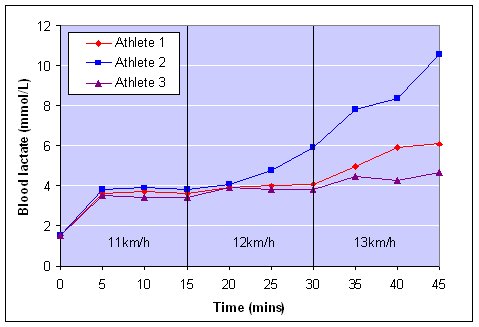Improving running performance can be achieved through the development of three components.
- Maximal Oxygen Uptake
- Lactate Threshold
- Running Economy

It has been suggested that these 3 variables alone account for over 70% of the runner’s variation in long distance running performance. Running programs have therefore focused their efforts on improving these three variables. However even still to this day research is unclear about the most beneficial way to improve these variables. Most training approaches have evolved by trial and error methods from the running community, with relatively little research being conducted by the sports science community.
One thing has become apparent, lactate threshold may hold the key to rapid improvements in running performance. Lactic threshold in running can be defined as the pace at which lactic acid accumulates and begins to inhibit muscle contractions. Many research papers have now suggested that the lactic threshold is one of the best predictors for long distance running performance.
Developing the lactic threshold of a runner first requires that you know the pace, heart rate or, if they’re experienced, the level on the register of perceived exertion scale. However I have always found pace to be the greatest piece of data to establish, as most running clients like to work at a pace rather than how they feel.
Without sending your client into a lab, you can complete 1 of 4 recommend field tests – recent research suggests that the 30 minute exam is the most accurate. To complete the 30 minute exam with a client you simply warm the client up, gradually bring the runner up to a speed that they believe they can maintain for 30minutes but not longer. Then start the 30 minute time. They can adjust the pace slightly but the focus is to find a consistent pace. The distance in metres is then divided by 1800 seconds; this gives you metres per second, which can be converted to minutes per mile. If you want to read into the testing protocol in more detail click here!
The lactic threshold pace can then be used in several interval programs to develop the runners lactate threshold, although researchers are yet still undecided upon the optimal training ratios, approaches and volumes. The following have shown positive results:
Maximal steady state training
Commonly referred to as Tempo Training in the running community, these are generally conducted at 5-10% below lactate threshold pace. Literature seems to suggest that these runs should account for no more than 10% of your clients’ weekly mileage on average.
Interval training above lactate threshold
There are numerous volume protocols and pace protocols for interval training to improve lactate threshold – the key point here is that pace during the session exceeds lactate threshold pace for short durations, followed by periods of recovery to remove lactate accumulation. Research has indicated that the following loading and intensities elicit improved lactate threshold.
- 4-6 x 2000m at 2s per 400m faster than lactate threshold pace
- 4-6 x 1600m at 4s per 400m faster than lactate threshold pace
- 5-7 x 1200m at 5s per 400m faster than lactate threshold pace
- 8-10 x 800m at 8s per 400m faster than lactate threshold pace
- 10-12 x 400m at 12s per 400m faster than lactate threshold pace
To calculate rest periods between intervals on all variations, simply take the time to complete the interval and use a ratio of 1:1. Recovery for most runners will be more efficient at a slow relaxed jog. Similar to maximal steady state training, total volume of intervals above lactate threshold should not exceed 10% of weekly volume on average.
